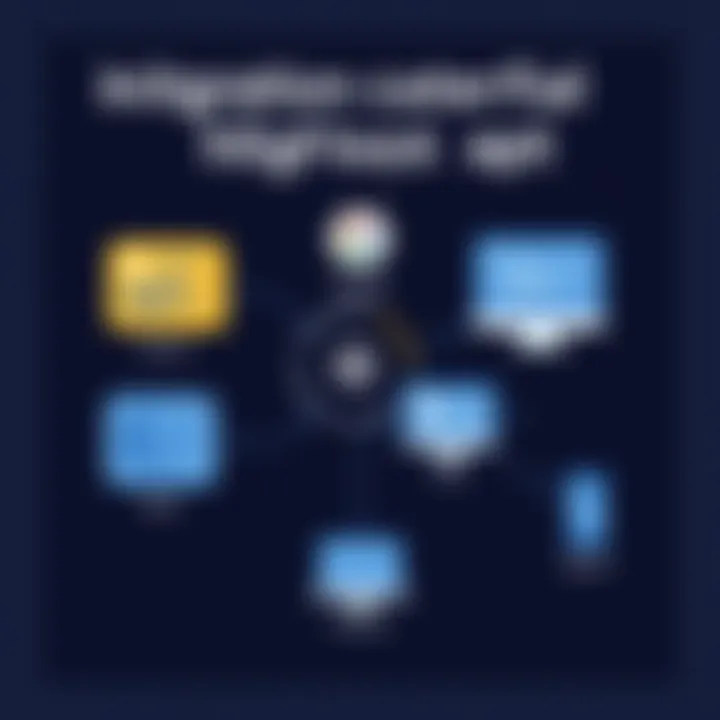A Deep Dive into the Highrise App for CRM and Collaboration


Intro
In the ever-evolving landscape of customer relationship management, tools like Highrise stand out for their ability to streamline interactions and cultivate lasting business relationships. This app has grown into a vital resource for both individuals and organizations looking to enhance communication and optimize workflows. Understanding the nuances of the Highrise app, its functionalities, and the experiences of its users helps in making a well-informed decision about whether it fits your needs.
Let’s take a closer look at this platform, starting with its purpose, the importance it holds in today’s business environment, and the current trends shaping the market.
Software Category Overview
Purpose and Importance
Highrise serves multiple purposes that are crucial for effective customer relationship management (CRM). At its core, it helps businesses to keep track of their interactions with customers, store relevant information, and categorize contacts all in one place. This centralization of data simplifies the management process and ensures that important details are never lost in the shuffle.
Moreover, Highrise aids in improving team collaboration by providing tools that allow different team members to connect seamlessly. Employees can share notes, set reminders, and assign tasks, making management of customer relationships more cohesive.
Current Trends in the Software Category
The CRM software landscape is continuously changing, driven by technological advancements and shifting business needs. Here are a few notable trends:
- Artificial Intelligence Integration: Many CRM platforms are now incorporating AI functionalities to provide predictive analytics, enhancing decision-making processes.
- Mobile Accessibility: As workforces become more remote, the need for mobile-friendly CRM solutions has increased. Businesses are looking for apps like Highrise that can be accessed conveniently, no matter where their employees are located.
- Personalization Customization: Modern consumers expect tailored experiences, influencing the demand for CRM systems that allow businesses to capture and analyze user data for personalized interactions.
- Focus on User Experience: The ease of use is becoming paramount. Users prefer platforms that offer a smooth onboarding experience and intuitive interfaces.
"The better the relationship with customers, the better the business could perform. Highrise is designed to facilitate just that."
Data-Driven Analysis
Metrics and Criteria for Evaluation
When it comes to evaluating the effectiveness of a CRM solution like Highrise, a few key metrics are typically considered:
- User Satisfaction: Feedback from users provides insight into the app's effectiveness, including elements like interface design and feature utility.
- Retention Rates: The frequency with which companies continue to use Highrise can illustrate its long-term value and role in ongoing customer relationships.
- Integration Capabilities: Understanding how well Highrise integrates with other tools is important. Many businesses rely on various platforms and the seamlessness of their interactions is key.
Comparative Data on Leading Software Solutions
Highrise doesn’t exist in a vacuum; it’s pivotal to consider how it stacks up against other popular CRM tools. For example:
- Salesforce: Known for its comprehensive feature set and robust integrations, but can be overkill for smaller businesses.
- HubSpot: Offers free services, making it attractive for startups, though it might lack some of the depth Highrise offers on customer relationship nuances.
- Zoho CRM: A versatile option but can be too complex for users who prefer simplicity, which Highrise provides.
As organizations weigh their options, understanding these comparative advantages is crucial in ensuring they select a CRM solution that aligns with their specific needs.
This exploration of the software category and the data-driven analysis related to Highrise sets the stage for a deeper examination of features and functions within the app itself.
Intro to the Highrise App
In the realm of customer relationship management, the Highrise app holds a pivotal position. Understanding what it brings to the table is crucial, especially for tech-savvy users navigating the often crowded marketplace of digital solutions. This section delves into what makes Highrise a notable player in the field.
Highrise is not just another CRM tool; it stands as a testament to simplicity in a world that sometimes overwhelms users with options. Its design philosophy and feature set directly address the needs of businesses striving for better communication and organization. The focus here is on usability and functionality, ensuring that even the less tech-inclined users find it manageable.
Overview of Highrise
Highrise was developed to streamline how teams interact with customers and manage tasks. Rather than packing every imaginable feature into a single platform, it prioritizes those that matter most to users. The clean interface invites users to manage contacts, track conversations, and handle tasks efficiently, without getting lost in unnecessary complexity.
The main components of Highrise include contact management, a reminder system, and robust note-taking capabilities. Its centralized approach allows users to keep everything in one place, fostering an environment that promotes collaboration. For professionals who rely heavily on client interactions, having a tailored solution like Highrise at their fingertips transforms a potentially chaotic workflow into a more streamlined process.
Purpose and Goals
The purpose of Highrise is clear – it aims to improve customer relationships while enhancing team collaboration. At its core, the application seeks to eliminate the friction often experienced in managing client interactions. Users can set reminders for follow-ups, tag important contacts, and even track the history of conversations. This structured approach leads to efficiency gains, nurturing customer relationships and ultimately driving business growth.
In discussing this further, the goals of Highrise can be distilled into two main categories. Firstly, it strives to enhance user experience through intuitive design and functionality. Secondly, it focuses on enabling organizations to foster better external interactions, transforming the way they communicate with their clients.
"The ultimate goal is to keep everyone on the same page to prevent any customer from slipping through the cracks."
Considerations around implementing Highrise often circle back to its adaptability across diverse business models—from small startups to larger enterprises. It creates the potential for improved accountability among team members, where task ownership becomes evident, thus facilitating a sense of responsibility.
By recognizing these core functionalities and purposes, users can appropriately evaluate how Highrise aligns with their specific needs, making it a critical choice for any organization aiming to optimize its customer relationship management.
Core Features of Highrise
The core features of the Highrise app stand as the backbone of its functionality, intricately designed to cater to the diverse needs of users, whether they are freelancers, small business owners, or large organizations. Understanding these foundational elements not only highlights the app's capabilities but also aids users in discerning how the tool aligns with their specific requirements. These features enhance productivity, foster collaboration, and optimize customer relationship management, making Highrise a vital component for businesses aiming to thrive in today’s competitive landscape.


Contact Management
Highrise offers a robust contact management system that serves as the vanguard of customer interaction. It enables users to compile, categorize, and maintain comprehensive profiles of all contacts, including customers, prospects, and partners. This is crucial for anyone who needs to keep track of multiple relationships without missing a beat.
For example, every contact can be enriched with relevant details such as notes, history of interactions, and associated tags. This layered information is instrumental in personalizing communications and enhancing customer engagement. Users are not just looking for names and emails; they want insights that help tailor their approach to each individual.
"Great relationships are built on great communication. Highrise helps you keep notes and stay organized so no detail slips through the cracks."
Additionally, the ability to filter and search contacts based on specific criteria drastically reduces the time it takes to find relevant information. Instead of fumbling through spreadsheets or disjointed platforms, everything is integrated and accessible in one place.
Task and Reminder Integration
Task management is another essential feature of Highrise that amalgamates with contact management to create a seamless workflow. Users can assign tasks related to individual contacts, ensuring that nothing falls through the cracks. This integration is particularly valuable in making sure follow-ups happen on time, enhancing overall effectiveness.
The reminder system allows users to set notifications for follow-up communications or any key actions that need to be taken. This proactive approach ensures that users are always ahead of the curve, able to juggle multiple responsibilities without feeling overwhelmed.
Notes and Tagging System
A swift way to capture ideas or thoughts during conversations is through Highrise’s notes and tagging system. This feature empowers users to jot down brief observations that can complement contact information. For instance, when meeting with a client, taking quick notes about their preferences can influence later engagements significantly.
Tags allow users to categorize contacts according to specific themes like industry, interest, or priority level. Leveraging these tags can facilitate easier searches and provide insights into trends among different groups. Users can quickly gauge the health of their relationships and make more informed decisions based on the aggregated data.
Email Integration
Email remains one of the primary modes of professional communication, which is why Highrise’s email integration is pivotal. The app enables users to link their email accounts directly, allowing for the syncing of conversations with contact records. Gone are the days of switching back and forth between email and task management platforms.
Notably, email threads can be viewed alongside contact profiles, providing a comprehensive backdrop against which to assess prior communications. Users can attach emails directly as notes or tasks, establishing a continuous thread of information that keeps past interactions alive and relevant.
The crucial interplay of these features means that whether you’re closing a deal, nurturing a client relationship, or managing a project, Highrise equips you with the tools necessary to handle it all with finesse.
User Experience and Interface Design
User experience (UX) and interface design are crucial aspects of any application, and the Highrise app is no exception. For businesses and professionals looking to streamline their customer relationship management and enhance team collaboration, a well-designed interface can make or break the user experience. When users find an app intuitive and easy to navigate, they're more likely to fully utilize its capabilities, leading to greater efficiency and productivity. Let's explore some of the integral components of Highrise's user experience.
Navigation and Usability
At the heart of Highrise’s effectiveness is its navigation structure. Good navigation means users can swiftly move from one section to another without feeling like they've gotten lost in a labyrinth. Highrise employs a straightforward layout that’s designed with the user in mind. Even those who may not be tech-savvy can find their way around the app without needing a roadmap.
- Intuitive Menus: The app features a clean menu layout that clearly categorizes different functionalities. This means you can easily access features like contact management, task creation, and more without digging through submenus.
- Search Functions: A robust search capability allows users to quickly locate specific contacts or tasks, enhancing usability. This comes in especially handy when the workload is hefty and time is of the essence.
Overall, the seamless navigation of Highrise ensures that users can get things done without unnecessary friction, ensuring increased usability.
Customization Options
Customization is another significant element in determining how user-friendly an app is. In a world where one size rarely fits all, Highrise provides ample opportunities for users to tailor their experience.
- Personalized Dashboards: Users can arrange their dashboards to highlight the information they find most pertinent, whether that’s recent activities, upcoming tasks, or important contacts. This helps in creating a focused environment tailored to individual work habits.
- Tagging and Notes: The ability to tag contacts and add notes means users can segment their customer base in a way that makes sense for their particular needs. For instance, a freelancer may want to tag clients based on project status, while a small business could categorize customers by purchase history.
These customization options empower users to mold the app to their unique business processes, enhancing not only the user experience but also their productivity.
Mobile App Experience
In today’s fast-paced world, the ability to manage customer relationships on-the-go is paramount. Highrise integrates this necessity perfectly with its mobile app experience.
- Responsive Design: Whether you’re on a tablet or a smartphone, the Highrise mobile app adjusts to the device’s screen size, ensuring a consistent look and feel across platforms. This offers a familiar environment regardless of how users access their data.
- Offline Access: One noteworthy feature is its capability to work offline. Users can still view and edit contact information or tasks without needing a stable internet connection, which is invaluable for those who often find themselves in areas with spotty service.
With these mobile capabilities, Highrise ensures users can maintain productivity regardless of where they are.
"A great user experience is about understanding the needs and behaviors of the users, coupled with a design that makes them feel empowered rather than overwhelmed."
Integration with Other Tools
The capacity for an application to integrate seamlessly with other tools and platforms is paramount in today’s fast-paced business landscape. In the context of Highrise, this integration plays a crucial role in enhancing its usability and effectiveness. Users are not just looking for standalone solutions; they desire a software ecosystem that works cohesively together. Highrise’s ability to connect with other applications allows users to streamline their workflow, eliminating repetitive tasks and ensuring their operations run smoothly.
Third-Party Applications
Highrise has gained notable traction due to its ability to integrate with various third-party applications. This feature is essential since it lets businesses tailor their tech stack according to their unique requirements. For instance, integrating Highrise with project management tools like Asana or Trello can provide teams a comprehensive overview of tasks alongside customer relationships. This synergy not only enhances productivity but also fosters better communication within teams. Here are some key benefits of its third-party application integrations:
- Enhanced Workflow: Collaborating with tools such as Slack or Zoom can create a central hub for team interactions, making discussions about customers more productive.
- Data Synchronization: Integrating with financial software like QuickBooks ensures accurate tracking of customer transactions, thus preventing data discrepancies.
- Custom Automation: Highrise offers integration with automation platforms like Zapier, allowing users to automate various tasks. For example, incoming customer inquiries can be automatically logged into the system without manual input.


Settling on the right third-party applications can drastically elevate the return on investment. The enhanced functionality serves as a bridge between disparate tasks, allowing organizations to reap the full benefits of digital tools.
API Capabilities
Another powerful aspect of Highrise is its robust API capabilities. For tech-savvy users and businesses with specific needs, accessing and manipulating data through APIs becomes an invaluable resource. The API allows developers to build custom integrations or applications tailored to their operational needs. For instance:
- Customization: Businesses can create custom solutions directly linking Highrise data with their own systems or databases, making it possible to pull crucial insights when they need them.
- Secure Data Exchange: Reliability in data exchange is vital, especially for companies dealing with sensitive information. The Highrise API adheres to stringent security protocols, ensuring that data remains protected throughout the integration process.
- Scalability: As organizations grow, their needs evolve. The API can easily be adjusted to accommodate changing workloads and integrate with newer applications, thus future-proofing their customer relationship management.
In summary, Highrise’s integrations with third-party applications and its API capabilities are more than mere enhancements; they form the backbone of a versatile platform. Users looking for a fluid amalgamation of tools will find that Highrise not only meets but exceeds expectations in creating a connected workspace.
"The real value of Highrise lies in its ability to integrate smoothly with other digital tools, ensuring users can work smarter, not harder."
For more information on API design and implementation, you can refer to resources like Wikipedia on APIs or dive into community discussions on Reddit.
Performance Metrics
Performance metrics are vital indicators that help businesses evaluate the effectiveness of various processes and tools. In the context of the Highrise app, these metrics are particularly essential as they guide users in understanding how well the app enhances their workflows and interactions, ultimately paving the way for strategic decision-making. By analyzing performance metrics, users can identify strengths, weaknesses, and potential areas for improvement. This facilitates not only a better understanding of operational efficiency but also a clearer view of customer satisfaction, which is paramount in today’s competitive landscape.
Efficiency in Team Collaboration
Team collaboration is often touted as the bedrock of successful businesses. Within Highrise, performance metrics related to team interactions can shed light on how well members collaborate. For instance, monitoring task completion rates, response times, and the frequency of communication can provide insights into team dynamics.
- Task Completion Rates: By examining how quickly tasks are done, users can identify which features streamline collaboration and which may require refinement. If team members are consistently missing deadlines, it may indicate a need for better task management or clarity in roles and responsibilities.
- Response Times: Tracking how long it takes team members to reply to queries or updates can unveil bottlenecks in communication. A sluggish response time might suggest that team members are either overwhelmed with their workload or that the tools used for communication aren't sufficiently effective.
"Measuring efficiency isn't just about numbers; it's about understanding the story they tell about your team's collaboration."
- Communication Frequency: Knowing how often team members interact can help identify whether they are engaged with each other and the project at hand. A high frequency of communication can indicate a proactive team, while a drop might point to disengagement or confusion surrounding shared goals.
Ultimately, these metrics equip teams with the information they need to enhance their effectiveness. Highrise enables this analysis through its integration of task management and communication tools, creating a robust framework for optimized collaboration.
Impact on Customer Relationships
Evaluating the impact of Highrise on customer relationships is another cornerstone performance metric worth exploring. Businesses depend on maintaining strong, positive interactions with their clientele, and Highrise is designed to bolster these connections.
- Customer Interaction Tracking: By tracking interactions with customers, users can gauge the frequency and quality of each touchpoint. Analyzing these metrics helps teams identify which communications resonate and which fall flat, enabling more targeted engagement strategies.
- Response Rates to Queries: Keeping an eye on how quickly and effectively the team responds to customer inquiries can highlight service performance. Fast and informative responses generally lead to higher customer satisfaction and retention rates.
- NPS and Customer Feedback: Tools like Net Promoter Scores (NPS) or direct feedback mechanisms can be integrated within Highrise to measure customer sentiment. Continuous feedback loops allow businesses to pivot and adjust their approaches as needed, ensuring they remain aligned with customer needs.
By leveraging these performance metrics, users can fine-tune their customer relationship management strategies. Understanding these dynamics not only enhances customer loyalty but also creates opportunities for growth, as businesses become more attuned to what their customers need and want.
In summary, performance metrics in Highrise serve as a navigational tool for teams and businesses, guiding them through the complexities of collaboration and customer interaction. This analytical edge ultimately ensures a competitive advantage in today’s bustling market.
Pricing and Plans
Understanding the pricing structure of the Highrise app is a crucial component of evaluating its value within the realm of customer relationship management and team collaboration tools. Pricing and Plans not only shape the user experience but also influence decision-making for individuals and organizations alike. For the discerning buyer, comprehending the nuances of tiers, features offered, and associated costs can be the difference between a good investment and a regrettable misstep. By examining the various subscription options available, we can gain insights into how these plans cater to the distinct needs of different user groups, be they freelancers or corporate giants.
Understanding Subscription Tiers
Highrise structures its subscription plans in a way that is accessible and flexible, aiming to accommodate a wide range of users. Each tier offers a balance of features that cater to specific user requirements. Generally, there are three main tiers: basic, professional, and enterprise, though the exact names might differ slightly.
- Basic Tier: This entry-level plan might be ideal for freelancers or small businesses just dipping their toes into customer relationship management. It typically provides access to core functionalities like contact management and basic task features without the bells and whistles that might overwhelm a beginner.
- Professional Tier: As businesses grow, so do their needs. The Professional plan often includes enhanced features, such as advanced analytics and additional integration options. This tier is suited for growing businesses with an evolving client base, allowing for increased productivity without breaking the bank.
- Enterprise Tier: Designed for larger organizations, this tier includes all advanced features and often comes with added customization options and priority support. Such flexibility is essential for corporations that need tailored solutions to manage extensive team workflows and customer bases effectively.
By presenting a tiered approach to subscriptions, Highrise allows potential users to find a plan that aligns both with their budget and their operational needs. Such a strategy not only widens its appeal but also facilitates scalability as user demands evolve.
Value Analysis
When assessing the value of the Highrise app and its plans, it becomes vital to weigh the benefits against the costs. A few factors play into this evaluation:
- Cost Efficiency: Consider how the features of each plan might lead to time savings and improved team productivity. For instance, enhanced task management and integration capabilities can reduce redundancies in workflows.
- Return on Investment: An important measure for businesses is the return generated from the subscription fee. A tool that helps to close more deals or maintain stronger client relationships justifies its expense.
- User Experience: The overall ease of use and effectiveness of the app can also make a significant impact. An intuitive interface is worth its weight in gold, as it can encourage higher adoption rates among team members.
- Customer Support: Access to responsive and helpful support can sometimes tip the scales in favor of one plan over another. The nuances in customer service can transform challenges into manageable scenarios.
Ultimately, a close examination of pricing and plans reveals not just the price tag, but the strategic alignment of the Highrise app with business objectives. By systematically analyzing how each subscription tier provides value to various user types, users can make informed decisions that support their operational goals.
"Investing in the right tools is investing in your future success".
By bringing together all these considerations, potential users will have a clearer perspective when navigating their options. For more detailed information regarding subscription costs and feature comparisons, visit Highrise's official site.
Whether you’re a small business on the upswing or a large enterprise with vast needs, understanding the pricing structure is vital to finding the perfect fit.
Effectiveness for Different User Types
In today’s marketplace, understanding how technology serves diverse user needs is crucial. The Highrise app stands out not just for its features but for its flexibility across different user types. Whether you are part of a small startup, a freelancer navigating your own path, or enmeshed in the complexities of a large organization, Highrise aims to meet you where you are. This section dissects how each category of user can leverage Highrise to enhance productivity, streamline processes, and foster improved customer relations.


Small Businesses
Small businesses form the backbone of the economy, but they often operate on tight budgets and limited resources. For these entities, Highrise provides a robust platform that can be immensely beneficial.
- Simplicity in Management: Small businesses can especially appreciate how Highrise simplifies contact management by allowing them to store and easily access essential information about customers and leads. This enables quick follow-up and relationship building which are critical at this size.
- Cost-Effective Solutions: With subscription plans that cater specifically to smaller-scale needs, small business owners find flexibility. They can opt for plans without overpaying for features they may not yet utilize, scaling their tools alongside growth.
- Streamlined Communication: Integrating with essential tools helps maintain smooth communication flows within small teams, ensuring that everyone is on the same page. This reduces the misunderstandings that can arise from miscommunication, enhancing team dynamics.
Freelancers
Freelancers often juggle multiple projects and clients, making organization a top priority. Highrise presents several features catering specifically to this user type.
- Project Tracking: The ability to tag and organize clients or projects simplifies the management of various commitments. Freelancers can keep all relevant information in one place, ensuring that nothing falls through the cracks.
- Customization: Freelancers have specific needs that may not align with generic tools. The customization options available in Highrise allow freelancers to tailor the app to better suit their workflow. This level of personalization can improve efficiency and free them up to focus on their core competencies.
- Client Relationship Management: Maintaining excellent relationships with clients is essential for repeat business. Highrise facilitates notes on every interaction, helping freelancers remember client preferences and previous discussions, which can be a game changer in building long-lasting partnerships.
Large Organizations
For large organizations, the stakes are different. They require robust solutions that can handle a significant volume of data and users without compromising efficiency.
- Team Collaboration: Large teams often face challenges in collaboration. Highrise provides a centralized platform where information is easily accessible. This transparency helps avoid information silos and promotes collaborative work.
"Effective collaboration is not about having the right tools; it's about creating an environment where communication flows seamlessly."
- Integration with Enterprise Tools: Large organizations typically use various systems for tasks like finance, HR, and project management. Highrise's capability to integrate with other software ensures data flows effortlessly between systems, fostering smoother operations.
- Scalable Solutions: As organizations grow, their needs evolve. Highrise offers scalable solutions and added features that can be adjusted as the organization scales, from managing additional customers to accommodating more team members.
User Feedback and Case Studies
User feedback plays a critical role in understanding how effectively the Highrise app meets the needs of its users. Insights gained from actual experiences inform prospective users about what they can realistically expect when adopting this tool. While the app may have impressive features, the real story often lies in its daily application in real-world scenarios across various industries. Case studies reflect not only the success stories but also the areas needing improvement.
By examining user feedback, businesses can pinpoint specific functionalities that resonate with their workflows and those aspects that might lead to frustration. This analysis aids potential users in their decision-making process and could influence future updates and enhancements of the app.
Positive User Experiences
Highrise has earned its fair share of praise from different sectors. Users often highlight the app's intuitive design which eases the transition for new adopters. One enthusiastic user, a marketing manager at a startup, shared:
"Highrise simplified our contact management process so much that I wondered how we managed before it. The ability to tag contacts makes finding relevant details a breeze."
The effectiveness of the task integration feature also comes up frequently in user reviews. For instance, freelancers appreciate the seamless way they can keep track of projects and deadlines all within one app. A graphic designer mentioned:
"I can quickly see my tasks and notes about clients without sifting through endless threads. This has saved me an incredible amount of time."
Furthermore, regular updates based on user feedback demonstrate the company's responsiveness to evolving needs. Frequent enhancements not only add new functionalities, but they also refine existing ones, showcasing a commitment to user satisfaction. Overall, users resonate well with the app's ability to foster organization and efficiency in their work.
Common Challenges
Despite its strengths, Highrise is not without its hurdles. Some users voice concerns about the learning curve associated with some of the advanced features. A project manager noted:
"It took us some time to fully grasp how to leverage all of Highrise's capabilities, especially the tagging and notes section. Training was essential for our team."
Moreover, integration with third-party applications has been mentioned as a double-edged sword. While users appreciate the capabilities this brings, they sometimes encounter synchronization issues. A common frustration highlighted was:
"When using integrations with other tools, we sometimes faced delays in updates, which affected how quickly we could access important information."
Lastly, some users reported that the app could feel overwhelming, particularly for individuals or small teams who may not need all the functionality it offers. Finding the balance between comprehensive features and user simplicity is an ongoing challenge that Highrise is currently navigating.
In summary, user feedback and case studies create a multifaceted view of the Highrise app's effectiveness. These insights help shape the future of the platform, guiding both new users and developers in understanding its strengths and areas for growth.
Comparison with Competitors
In the tech landscape, especially in customer relationship management, competition is both fierce and essential. Understanding how Highrise stacks up against its competitors is key for users looking to make informed choices. It provides insights not just about features but also about performance, usability, and overall user satisfaction. By dissecting these elements, potential users can align their specific needs with what each platform delivers.
Highrise vs. Alternatives
When stepping into the realm of CRM solutions, one finds a plethora of options such as Salesforce, HubSpot, and Zoho. Each boasts unique features, but how does Highrise hold its ground? Here are a few points of comparison:
- Simplicity vs. Complexity: Highrise is known for its straightforward interface. Unlike Salesforce, which can be an overstuffed suitcase of features, Highrise retains ease of use. This focus on simplicity allows users to manage contacts and tasks without grappling with a steep learning curve.
- Customization Options: While platforms like HubSpot shine with customizable dashboards, Highrise remains less customizable. This might deter some, but for users who prefer ready-to-go solutions, it can be a blessing.
- Pricing Models: Highrise offers transparent pricing, typically lower than many alternatives. For small businesses and freelancers, this is a considerable factor. Unlike some competitors that may hide costs behind complex tier structures, Highrise lays it all bare.
- Customer Support: Many users have commented on Highrise's customer service as being personal, reflecting a smaller team behind the software. This contrasts with giants who may provide support through extensive FAQ sections, but lack personalized assistance.
In essence, choosing Highrise over alternatives boils down to what the user values most. For those who appreciate straightforwardness, affordability, and personal touch, Highrise can be a clear winner.
Market Positioning
Highrise’s position in the CRM market is as distinctive as a tailored suit in a rack of off-the-shelf options. It caters primarily to small businesses and freelancers, carving out a niche that larger competitors often overlook. This specific targeting brings several advantages:
- Audience Alignment: By focusing on small-scale operations, Highrise designs features that resonate with the day-to-day struggles of small teams. This ensures that the app addresses genuine user pain points instead of trying to be everything for everybody.
- Community Engagement: Highrise often fosters a sense of community. This engagement not only helps bring in feedback for improvement but also creates a loyal user base that values relationship-building over mere customer numbers.
- Brand Identity: Highrise brands itself as a tool for connection rather than just manipulation of data. Its marketing speaks to those who prioritize human interactions, standing out amidst the noise of competitive offers that emphasize analytics and automation above all.
- Continued Evolution: Highrise consistently explores user feedback, adapting features that align closely with client demands. This agility offers an edge in a market that often struggles with inertia.
block







